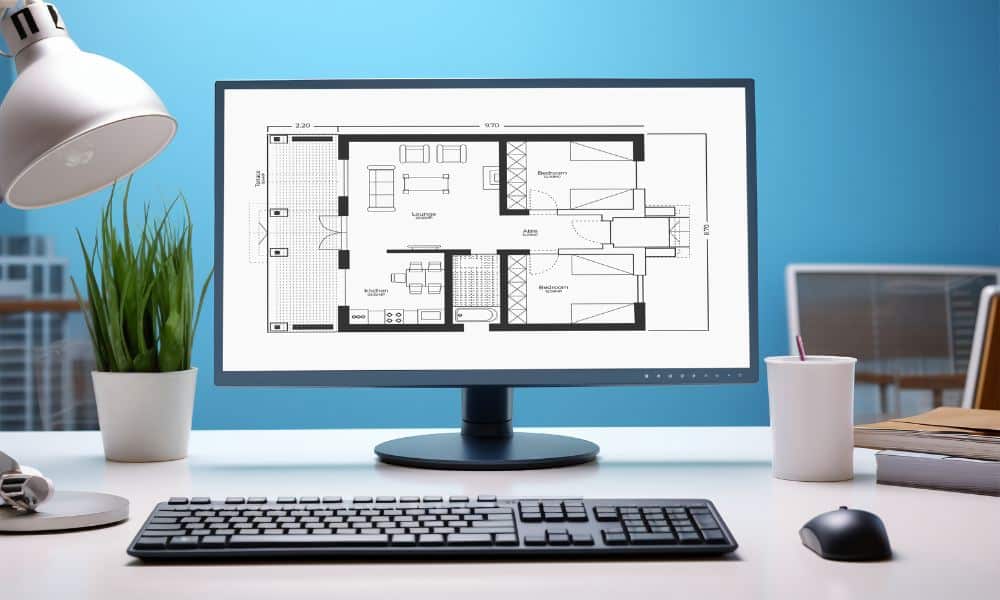The Ultimate Guide to Architectural Site Analysis
Gourav Jain
- August 19, 2023
- 9 Min Read

When starting an architectural project, architectural site analysis is one of the crucial aspects that pave the way for success. It defines a detailed inspection/examination of the site’s characteristics and surroundings. The characteristics and the site’s unique features help architects maximize their potential to create structures that blend seamlessly with the environment and surroundings.
Let’s learn about the significance of site analysis architecture and explore how it can shape the design process.
What is Architectural Site Analysis?
Architectural site analysis is an extensive assessment of a site’s physical, social, historical, environmental, and other contextual aspects that informs the design of a building or any other space. These assessments are generally done visually, and the site analysis diagrams are used to build the building. Site analysis architecture is fundamentally done in the pre-design phase of an architectural design process that helps develop a concept for the design.
The architects analyze the site to gain in-depth insights into the site’s strengths, restrictions, and potential. Architects can make more informed decisions by evaluating climate, topography, vegetation, and surrounding context.

Redefine Architectural Possibilities
Our platform equips you with the tools to streamline your project lead management, collaborate seamlessly, and push the boundaries of design. Embrace innovation with Lio today.
Importance of Architectural Site Analysis
Architectural site analysis is crucial for the architectural design process. Below are some key points that highlight its significance:
Informed Design Decisions
Site analysis provides crucial information about the site’s characteristics to the architects. This information enables them to make informed design decisions. Certain factors, such as climate, topography, and surrounding context, influence architectural design decisions related to building orientation, materials, and spatial organization.
Maximizes Design Potential
The thorough assessment and analysis help architects identify the unique strengths and opportunities in the design. The in-depth architectural site analysis allows architects to leverage the site’s positive components, such as favorable views, natural features, or access to resources, which they incorporate into their architectural design.
This approach maximizes the project’s potential and creates a harmonious relationship between the building and its surroundings.

Enhances Sustainability
Another crucial significance of site analysis is it helps architects identify sustainable design options. Architects can optimize natural ventilation, daylighting, and energy efficiency by studying historical data and climate patterns. Moreover, the existing vegetation and landscape research allows them to integrate more green spaces and preserve ecological balance.
Addresses Environmental Factors
Site analysis architecture allows architects to identify and assess potential environmental challenges and design impactful solutions to minimize their impact. Architects can develop robust designs that help minimize risks and enhance individuals’ safety and well-being by carefully understanding flood zones, seismic activity, or noise pollution.
Contextual Integration
Every site has a unique context shaped by neighboring buildings, streets, and infrastructure. Site analysis helps understand this context and ensures the projected design aligns with the surrounding environment. Architects can create vibrant and visually appealing designs by considering neighboring structures’ architectural style, scale, and visual impact.
Feasibility and Efficiency
Architectural site analysis ensures that the proposed design is feasible and efficient. Architects can plan and allocate resources effectively by understanding the availability and capacity of the resources and avoiding expensive and time-consuming modifications during the construction phase.

Elevate Your Architectural Workflow
Ready to take your architectural projects to new heights? Our project management tools cater specifically to architects, helping you stay organized, collaborate effectively, and deliver exceptional results.
How to Conduct Site Analysis?
Architects and designers follow a systematic process to collect significant information about the site. Below we have stated a step-by-step guide on how to perform site analysis architecture:
Site Visit and Observation
The first and foremost step of architectural site analysis is physically visiting the site and observing every detail. Architects should walk around, explore different areas, and understand the site’s characteristics. Moreover, they should also pay attention to the surroundings, existing structures, vegetation, and other notable features. Architects should take photographs, make notes for references, and document observations.
Gathering Data and Information
After the site visit and observation, architects should gather more specific data and information about the site. Specific data simply implies climate information, topographic maps, and resource plans. Architects should consult local authorities, obtain climate data from meteorological sources, or use surveying tools to measure the site’s physical attributes.
Analysis and Interpretation
After the site analysis the research data are useless if you cannot analyze or interpret them. So, after gathering significant data, architects should analyze and interpret their findings. Identify the site’s strengths, limitations, and opportunities for design.
Documentation and Reporting
Documentation of the site analysis findings is crucial for future reference and communication. Architects can prepare site analysis architecture sheets or reports to summarize the data collected, observations, and analysis. Remember, when reporting, use clear language and maps, diagrams, and photographs to clarify your research and analysis.
What are Site Analysis Sheets?
Site analysis sheets are structured documents or forms used by architects and architectural designers to record and organize information systematically during the site analysis. Site analysis sheets are a valuable tool for documenting the research findings, observations, and data related to various aspects of the site.

Components of Site Analysis Sheets
As mentioned above, the designers and architects use the site analysis sheets to document and organize their analysis and research. The key components in site analysis sheets include:
Site Description
The description provides a detailed view of the site, including its location, size, and boundaries. Moreover, it also provides any historical or cultural significance related to the site.
Climate and Weather
Understanding local weather patterns, temperature ranges, and prevailing winds is essential for designing buildings to maximize energy efficiency and occupant comfort.
Topography and Landform
Architects analyze the site’s topography, which includes elevation changes, slopes, and landforms, to determine the best placement and orientation of the structures.
Vegetation and Landscape
The site’s existing vegetation assessment, including trees, shrubs, and natural features, helps architects to integrate the landscape into their design and preserve its ecological balance.
Surrounding Context
Evaluating neighboring buildings, streets, and infrastructure helps architects understand the site’s relationship with the surrounding environment.
Infrastructure and Services
Assessing the available resources such as water, electricity, sewage, and transportation networks is also essential for ensuring the feasibility of the projected design.

Master Architectural Project Execution
Master the art of architectural project execution with our tailored project management solutions. Streamline tasks, enhance communication, and drive success in every phase of your projects.
Tools and Techniques for Architectural Site Analysis
Architects have an array of software and tools to perform effective site analysis. Below we have listed the different software they use:
Site Analysis Software
Several tools help generate accurate 3D models, map and visualize the site data. These tools help architects in analyzing different aspects of the site efficiently.
Data Collection Instruments
Architects gather data on the site’s physical components, climate, and environmental aspects using measuring tools like GPS devices, drones, and environmental sensors.
Visualization and Presentation Tools
Architects use designing tools to create diagrams, maps, and renders to communicate their site analysis architecture effectively to their clients, stakeholders, and other project teams.
How Lio can help you in Site Management?
Site analysis and research data management is a complex task that takes a lot of time and manual efforts. Thanks to the Lio app, you can now easily manage all your site research and analysis data in a single place. This all-in-one project and workflow management app has in-built customizable data management, workflow optimization, and resources management apps that let you manage all sorts of workflow together in a more organized way than ever.
This cloud-based project management tool helps you visualize your data through real-time business dashboards, generate reports instantly, collaborate with your team, and share significant data while working on your site.
The many features of Lio allow you to manage your site, analyze & document your day-to-day operations and ensure you have all your project’s data organized and on track. If you want to manage your project workflows, resources, tasks, and data in a single space, then the Lio app is the best solution you would need.
Besides all these, you can also track your site estimates, make budgets, keep an eye on project finances, create dashboards, collaborate with your team in real time, and automate your project or site management workflow all in one go. You will certainly manage your site more efficiently if you go on this journey of managing it with Lio.
Conclusion
Architectural site analysis is an essential part of the architectural design process. Architects can build spaces or buildings seamlessly blending with their surroundings by meticulously evaluating the site’s characteristics while optimizing energy efficiency and sustainability.
Architects can create remarkable structures that enrich the built environment by implementing site analysis sheets, leveraging advanced software, and embracing the benefits of informed design decisions.
Frequently Asked Questions (FAQs)
What are the steps of site analysis?
Basically, site analysis has 4 steps:
- Site visit and research
- Collect the data
- Analysis and interpretation
- Documentation and reporting
What are the natural factors of site analysis?
The natural factors of architectural site analysis include geology, vegetation, wildlife, topography, hydrography, climatic factors, etc.
What is topography in site analysis?
Topography signifies studying the site’s physical attributes under construction. Physical attributes such as shape, form, landform, etc.
What are site analysis diagrams?
Whenever any architect or designer visits a site, they conduct site analysis, and whatever they find or observe, they represent it visually. The visual representation of analysis and data are site diagrams.
What are the stages of site analysis?
In architecture, site analysis is defined as the first step of any construction divided into three stages – Research, Analysis, and Synthesis.
Can Lio help you in architectural site management?
Lio is an all in one workflow and project management tool that helps you document, record and manage your project workflows in one place. Architects can easily manage their project analysis and research data, resources, and workflows and collaborate with their team in real-time. You will find managing your site and projects much easier on this all-data and workflow management app. You can call our sales and support team for more information.

















